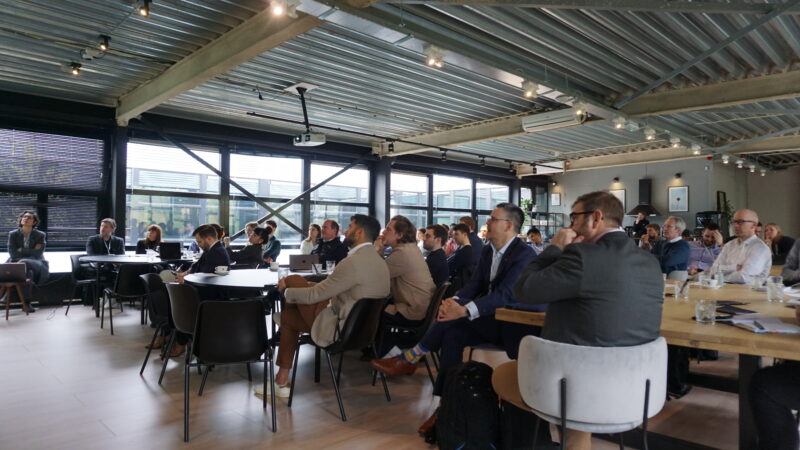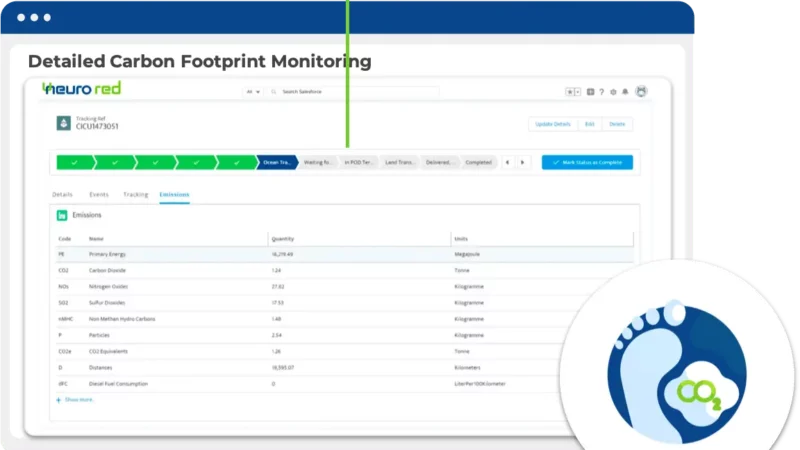FAQ
A complex tool like EcoTransIT World raises questions. Find the most frequently asked here.
-
EcoTransIT World is a flexible tool for complex calculations that supports companies to calculate and optimise their emissions and energy consumption. The software is accredited by Smart Freight Centre to be in accordance with the GLEC Framework, and also meets the requirements of EN 16258 and the GHG protocol (Corporate Standard). ETW allows calculation of complete transport chains across all modes of transport (truck, train, ocean-going vessels, inland water vessels, aircraft) including transshipments/warehousing worldwide on the basis of a scientific and neutral methodology.
-
- Intermodal: ETW is able to calculate any transport chain, combining different modes of transport.
- Global: ETW allows the user to calculate the ecologic footprint of complex global supply chains.
- Routing: A global traffic network is available for each mode of transport (road, rail, inland waterway transport, ocean shipping routes, air transport). The large volume of GIS data allows calculation of precise routing, thereby considering transport-specific aspects such as ferry transport for trucks, electrification of railroads, Emission Control Areas (ECA zones) for ocean shipping.
- Flexibility: The Business Solutions offered by ETW allow immediate use of the standardised interfaces as well as individual solutions according to specific customer requirements.
- Simple: ETW is simple to use because little basic data, such as gross weight (t, kg, t/TEU for container transport), start and destination, and mode of transport are sufficient to calculate the emissions. Additional information may be used to enhance and individualise the calculation and to make it more precise.
- Up-to-date: ETW is constantly developed and regularly adapted to state-of-the-art technology.
- In accordance with standards: ETW is accredited for the GLEC framework and also complies with EN 16258 and the GHG Protocol (Corporate Standard).
-
Using ETW does not automatically reduce emissions. However, it supports companies in doing so by making emissions and energy consumption transparent. This puts the user in the position to optimise transport from an ecologic point of view. You can only manage what you can measure!
-
Only a few basic criteria are needed to calculate: Gross weight (tons, TEU, tons per TEU), origin and destination location, and the respective transport modes. To increase the calculation accuracy, additional transport parameters can be defined, such as the vehicle type, fuel type, load factor or emission class. Parameters that are not specified will be filled with the ETW default values.
-
ETW holds over 12 million postal codes, over 98,000 UN/LOCODEs, over 9,000 IATA codes, and approximately one million city names. We do everything possible to maintain the high quality of the GIS data in ETW. To do this, we continuously add new locations. In addition, we provide our Business Solutions customers with a dedicated interface called LocationEditor. We have developed the LocationEditor to allow users of ETW to add customer-specific locations not yet available in the system.
-
ETW covers all standard truck types, train categories, ocean vessels including RoRo vessels/ferries, inland waterway vessels and all currently used aircraft types. These can be freely combined on any route to design intermodal transports.
-
For every leg of a transport, ETW calculates:
- Energy consumption
- Greenhouse gases as CO2 and CO2e
- Nitrogen oxides (NOX)
- Sulphur oxides (SOX)
- Non-methane hydrocarbons (NMHC)
- Particulate Matter (PM10)
- Distances/detailed routing information
each as Well-To-Tank (WTT) and Tank-To-Wheel (TTW). Depending on the interface, the results can be split by country and/or traffic type. Beyond this, the routed transport can be exported in KML format.
-
The calculation of the energy consumption and emissions in ETW follows the following steps:
- Calculation of the route information by the internal ETW routing algorithm.
- Splitting of the route into relevant sections to match individual parameters, e.g. road type or electricity mix of various countries.
- Calculation of the basic emission parameters based on the characteristics of each section and description of the transport (for example vehicle type and emission category, propulsion type/fuel type, country characteristics, …)
- Calculation of the energy consumption and the emissions by using a respective formula based on freight type, the basic emission factors, transport distance, freight allocation, loading factor and empty trip factor for each relevant section.
- The sum of all sections is the total emission of the transport.
The greenhouse gases (CO2, and CO2e) are calculated on the basis of the fuel consumption. To do this, all standard fuel types including country-specific bio-mixtures are stored in ETW. The calculation of the air pollution depends on the vehicle type, its technical specifications, e.g. a catalyst or the emission category. As this calculation is substantially more complex than calculating the greenhouse gases, only a small number of emission calculators cover the calculation of air pollutants. ETW calculates greenhouse gases and air pollutants globally for all traffic types. This is unique worldwide! ETW also considers the upstream supply chains that enable transportation. These are referred to as Well-To-Tank (WTT): A few processes are necessary before a vehicle can consume fuel/electricity. This includes production, provision, refinery and supply of the fuel. In the calculation, in accordance with EN 16258, consideration of WTT emissions is obligatory and therefore of course fully integrated in the ETW calculation. The complete ETW methodology is made available in an elaborate methodology report on the ETW website.
-
ETW addresses a wide target group:
- Logistics service providers (LSP)
- Carriers
- Shippers
- Software provider or consultants
- Organisations and others.
Up to now, ETW was particularly beneficial for LPSs with many sub-contractors because ETW allows including the scope 3 emissions of pre- and oncarriage easily and accurately.
-
Many stakeholders in the international freight transport sector demand measurement of the ecologic footprint of transport or it is ruled by the companies’ obligation to transparency. In many countries, companies of a certain size are obliged to prepare an environmental report which also requires covering the emissions. In France, the indication of emissions and energy consumption of a transport is required by law. And more and more consumers are interested in sustainability, making the conservation of the environment a more significant topic in transportation. But also, from the economic point of view, using ETW can be worthwhile: A low ecologic footprint saves fuel and CO2 and consequently money as well. The results produced by ETW are already used by many companies to prepare sustainability reports, take corporate decisions, or in corporate communication.
-
Basically, starting and destination points, gross weight, and mode of transport are sufficient for a calculation. All other assumptions are then supplemented on the basis of default values determined by our scientific partners ifeu, INFRAS, and Fraunhofer IML. These details are added to the calculation and displayed in the result. Of course, these default values may be replaced or amended by customer-specific values.¬ This means: the more detailed the transport information, the more accurate the result will be. This is why it is recommendable to include as much transport information to the calculation as possible. As part of our Business Solutions, we advise customers on which information has a major influence for a more precise result and which plays a subordinate role (e.g. truck emission categories, if only CO2 emissions need to be calculated).
-
The EcoTransIT World Initiative (EWI) closely cooperates with independent environmental organisations (ifeu, INFRAS, and Fraunhofer IML). ETW’s calculation algorithms are validated by our scientific partners ifeu and INFRAS prior to each release. The correct application of the methodological specifications is confirmed in writing by these organisations in a “Methodology Confirmation”.
Currently, it is not possible to have a tool for the calculation of environmental emissions of global transport chains certified. However, intensive work is being carried out on an international standard (ISO 14083). ETW’s scientific partners accompany this process, as do some members of the EWI.
Within IVE mbH, the processes relating to ETW have been certified according to the ISAE 3402 standard.
-
Whilst using the free emission calculator available on the ETW website requires a substantial amount of manual work, the professional interfaces provided by the Business Solutions allow calculating thousands of transports automatically. With this offer, Business Solutions mainly addresses companies wanting to calculate thousands of transports or shipments automatically. You will find more information here
-
The Business Solutions are perfectly suited for companies that want to automatically calculate large amounts of transport/shipment data. Since these data no longer have to be entered manually, the use of Business Solutions saves a lot of time. Thanks to the use of modern interfaces, basically every application case is scalable, whether for company or individual customer reports, benchmarks or analysis calculations.
-
ETW can be made available to companies very quickly. Using the online calculation on the website is free of charge for individual transport calculations as long as the results are marked accordingly. Business Solutions offer professional users means to automatically calculate a large number of transports directly and without manual input. Well-tested and proven standardised interfaces are available for this. The interface best suited for an individual company and how to deploy it is best discussed in a personal or web meeting. The best way to contact us is by email.
-
Data is transferred either via an XML web service (WSDL) or via an online upload in CSV file format. Optionally, ETW can be integrated into the customer’s own website. It is possible to integrate the page as an iFrame or via SOAP-XML web service.
-
The annual license fees depend on the license type; they include support and the provision of a server, and allow unlimited use of all interfaces. In addition, there are one-off costs for provision (hardware and setup), consultation, and the software packages used. Which license is the ideal solution for your company and how to use it is best discussed in a web meeting. Simply contact us by email.
-
EcoTransIT offers different solutions for users, each of which can be adapted to individual customer-specfic requirements:
Standard User License: The solution to calculate all transports carried out on company’s waybill. The annual license fee depends on the company’s turnover.
Shares License: Applicable for calculations that are carried out on behalf of third parties. In this ccase, the annual license fee results from the number of calculations carried out.
Calculation Serivce: Execution of calculations for shippers and transport companies based on their transport lists. There is no annual license fee for this service; teh costs are calculated according to expenditure.
-
The number of transport requests that can be processed per time interval depends on the following factors:
- Type of transport (a transport with pre- and oncarriages including transfer point analysis requires more processing time than a simple transport from A to B)
- Hardware performance
- Interface used and its correct use
In general, it can be said that a request is processed between 0.001 and 30 seconds. The figures apply per server. By scaling the number of servers, this number of calculations can be further increased.
-
With the LogViewer module, companies can analyse the quality of their calculations. The LogViewer covers the number of calculations, the calculation time per transport, the transport types used and detailed information about failed calculations. This gives the user an exact picture of the interface performance. The user of the LogViewer can filter individual views and automatically receive respective reports by e-mail in freely definable periods of time. Together with the LocationEditor, problems in calculations can be identified and directly improved.
-
Each license includes a fee for server support and user support. The remaining income from the license fees is allocated to the so-called EWI budget. EWI decides how the funds are used. Some examples:
- Continuous further development of the methodology with ifeu, INFRAS or Fraunhofer
- Update of existing methodologies for renewed sources, such as HBEFA or IMO-Report
- Operation of public servers, for example the website
- GIS data, such as the worldwide postal code layer or the European road network
- OAG flight timetables
- Marketing activities
This budget which increases with each new customer ensures that ETW is constantly updated and expanded and is therefore always state-of-the-art.
-
Data security is very important to us. Therefore, we have developed comprehensive security measures to prevent company-specific data from reaching third parties or other users of our Business Solutions. Examples are the following measures:
- Requests to our interfaces are transmitted encrypted via SFTP or https
- All servers are protected by a double firewall
- Company data is stored in separate databases on company-owned servers
If these standards are not sufficient for a user, it is also possible to install a server directly in the company’s data centre and thus protect it from attacks behind the company’s own firewall.
-
The Business Solutions are offered as Software-as-a-Service. Therefore, there are no other requirements other than an internet connection to use ETW.
-
EWI has been behind ETW since 2012. Members of EWI are users of ETW, who not only use this tool, but also want to develop it further. Users of ETW Business Solutions (licensees) are invited to participate in EWI. The members of the EWI come from different economic sectors and include logistics service providers (LSP), carriers, shippers and other organisations. Although there are also competitors among the members, the only objective is to develop a tool with which emissions and energy calculations for freight transport can be carried out in a transparent, fair, accurate way with comparable results. ¬ The EWI Governance Rules regulate, among other things, the type of communication and coordination processes of EWI members. Furthermore, the EWI Governance Rules contain clear rules to avoid agreements on cartels (antitrust). Each EWI member is committed to sign and adhere to the EWI Governance Rules. In recent years, more and more users of ETW have joined the EWI. In addition to know-how, each new member contributes their own point of view. That is what makes the EWI so special: It is not about a single mode of transport or a single company, but it covers the complete sector on a global scale.
-
The EWI is an independent industry-driven platform for carriers, logistics service providers and forwarders who use Business Solutions. EWI has set itself the goal of continuously developing and harmonising the methodology to determine emissions in the global transport sector and consequently make the ETW a globally recognised tool. In addition, EWI cooperates with other initiatives and organisations, scientific institutes and NGOs to harmonise the calculation methodology of the CO2 footprint and other environmental impacts in the international transport of goods.
-
EWI members meet regularly in virtual meetings and physically once a year. Main functions of EWI are, for example:
- Election of the EWI Steering Committee (every second year)
- Adoption of the EWI budget
- Information on methodological and general developments of ETW, in particular in Business Solutions
- Decision on EWI membership
Within EWI, there is also the Methodology Group which discusses and coordinates the upcoming methodological adjustments on a small scale in cooperation with the scientific partners. If necessary, further working groups dedicated to special subject areas can be set up.

Methodology
 Scientifically sound
Scientifically sound
Events
 EcoTransIT World Insights Webinar
EcoTransIT World Insights Webinar
News
 Emissions Tracking on Salesforce AppExchange
Emissions Tracking on Salesforce AppExchange

